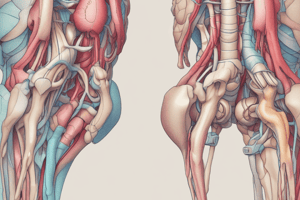Podcast
Questions and Answers
Which joint allows for a limited degree of movement?
Which joint allows for a limited degree of movement?
- Epiphyseal plate of cartilage
- Symphysis pubis (correct)
- Suture joint
- Intervertebral union
What connects the articulating bones in a secondary cartilaginous joint?
What connects the articulating bones in a secondary cartilaginous joint?
- Elastic cartilage
- Fibro-cartilage (correct)
- Hyaline cartilage
- Adipose tissue
Which type of movement is associated with the epiphyseal plate of cartilage?
Which type of movement is associated with the epiphyseal plate of cartilage?
- Limited movement
- No movement (correct)
- Free movement
- Rotational movement
Which of the following is NOT an example of a secondary cartilaginous joint?
Which of the following is NOT an example of a secondary cartilaginous joint?
The diagram of the human spine and pelvis highlights which of the following features?
The diagram of the human spine and pelvis highlights which of the following features?
Study Notes
Secondary Cartilaginous Joints
- These joints have a disc made of fibro-cartilage which connects the bones.
- Offer a limited range of movement.
- Examples include the symphysis pubis, which connects the two pelvic bones, and intervertebral joints between vertebrae in the spine.
No Movement Joints
- These are not technically joints but are areas of cartilage that are present during growth.
- An example is the epiphyseal plate of cartilage between the epiphysis and diaphysis of a long bone.
Example diagram
- The diagram illustrates the human spine and pelvis.
- The spinal cord runs through the spine and spinal nerves branch off it.
- Intervertebral discs are present between vertebrae.
- The symphysis pubis joint in the pelvis is shown.
- The epiphyseal line on a long bone is labelled.
Studying That Suits You
Use AI to generate personalized quizzes and flashcards to suit your learning preferences.
Description
Explore the fascinating world of secondary cartilaginous joints and non-movement joints in human anatomy. This quiz will delve into their structures, examples, and functions, including a focus on the symphysis pubis and intervertebral discs. Test your knowledge of these essential components of the skeletal system with visual aids.




